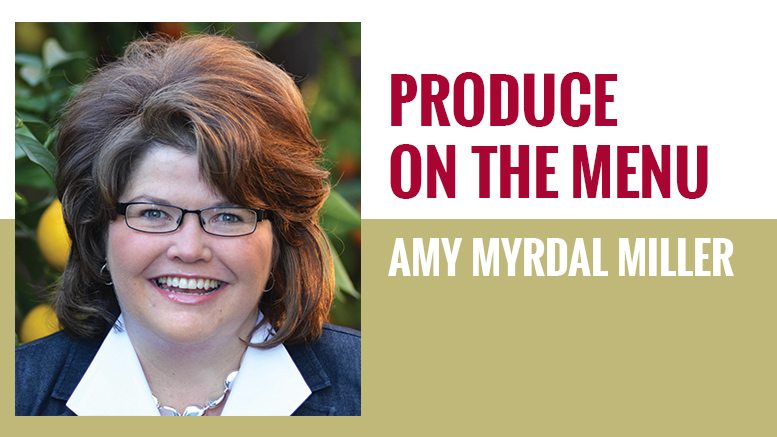How the ‘Have A Plant’ Movement Could Drive Produce Sales in Foodservice
February 1, 2020 | 4 min to read
At the 2019 Consumer Connection conference, the Produce for Better Health Foundation launched the Have A Plant consumer campaign, aimed at increasing fruit and vegetable consumption by tapping into emotional connections. With the help of influencers, the campaign is integrated into various sectors, including K-12 schools, campus dining, chain restaurants, contract foodservice, and convenience stores. This initiative promotes healthful, sustainable eating and enhances brand equity while encouraging the adoption of plant-forward menus across foodservice operations.

Originally printed in the February 2020 issue of Produce Business.
At the 2019 Consumer Connection conference in Scottsdale, AZ, the Produce for Better Health Foundation (PBH) announced its new Have A Plant consumer campaign, released the new Have A Plant logo and launched the new FruitandVeggies.org website.
According to the PBH website, the Have A Plant movement is “a way” to tap into the emotional connection consumers have to the fruit and vegetable eating experience while inspiring long-term, sustainable behavior change.” The site goes on to say, “Have A Plant…will inspire consumers with compelling reasons to believe in the powerful role fruits and vegetables can play to fuel happy, healthy and active lifestyles.”
Promotion of the Have A Plant movement has been impressive. Led by the PBH Fruit and Vegetable Ambassadors in Action — a powerful group of 15 nutrition, health and lifestyle influencers — Have A Plant messaging and images quickly infiltrated social media. Various brands across the produce industry are already using Have A Plant in their marketing campaigns. One of the next phases in this movement is enlisting leaders in foodservice to use Have A Plant in their operations to increase the purchase intent for plant-forward, fruit and vegetable-rich menu items.
Here are five ways Have A Plant could help increase consumption of fruits and vegetables in a variety of foodservice operations.
1) IN K-12 SCHOOLS
Any school currently participating in the Let’s Move Salad Bars to Schools campaign can use Have A Plant to drive student interest in salad bar offerings. Members of the Culinary Institute of America (CIA) Healthy Kids Collaborative, a group of culinary and nutrition professionals from small, medium, and large districts across the country, as well as leaders from contract dining operations with K-12 contracts, have been developing and testing plant-forward and plant-based recipes for schools. Using Have A Plant to promote these menu items is one way they can increase demand for these offerings.
2) IN CAMPUS DINING
Many of the leading campus dining operations in the United States — schools like Stanford, Michigan State University, Yale and the University of Massachusetts Amherst — have been developing and presenting plant-forward menus for many years. Their students are interested in foods, beverages and eating patterns that promote health for humans as well as the health of the planet. Using Have A Plant can drive student interest in new plant-forward menu items, especially if promotions also focus on the emotional benefits of diets rich in fruits and vegetables as well as sustainability messaging related to where and how the produce was grown.
Smart operators will incorporate Have A Plant into promotions, including social media, to enhance brand equity, especially for brands positioning themselves as offering more healthful, sustainable menus.
3) IN CHAIN RESTAURANTS
Have A Plant is perfectly positioned to drive purchase intent for limited time offerings (LTOs) that feature abundant use of fruits and vegetables. It can also be used to promote the addition of popular items like avocados that add valuable nutrients, appealing textures and help drive up check averages. Have A Plant can also promote specific sections of the menu like vegetable side dishes or fruit-filled smoothies. Smart operators will incorporate Have A Plant into promotions, including social media, to enhance brand equity, especially for brands positioning themselves as offering more healthful, sustainable menus.
4) IN CONTRACT FOODSERVICE
Contract foodservice companies are often competing not only on price but also on various specifications related to health and sustainability. Integrating Have A Plant into their offerings for employee dining programs could make their offers more competitive, especially for companies concerned with employee health and rising healthcare costs. The messaging around Have A Plant that talks about emotional as well as physical health is compelling for any HR professional seeking ways to enhance productivity, job satisfaction and employee retention in today’s workforce. With unemployment rates low, companies need every competitive advantage possible to retain talented people.
5) IN C-STORES
While many in the convenience store industry joke about being purveyors of “smokes and Cokes,” leaders in this category are focused on providing a greater variety of fresh, healthful options. Joining the Have A Plant movement is a competitive advantage for a foodservice sector that is striving to stay relevant with today’s demanding consumers. Have A Plant can also provide a public relations boost and puts attention on offerings like smoothies, salads and single bananas.

Amy Myrdal Miller, MS, RDN, FAND is a farmer’s daughter from North Dakota, award-winning dietitian, culinary nutrition expert, and founder and president of Farmer’s Daughter Consulting, Inc. She is the director of The Culinary Institute of America Healthy Menus R&D Collaborative and a consultant for the Produce for Better Health Foundation. You can learn more about her business at www.farmersdaughterconsulting.com, and you can follow her insights on food and flavor on social media @AmyMyrdalMiller
5 of 16 article in Produce Business February 2020

